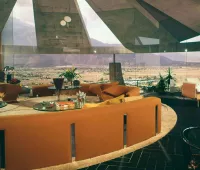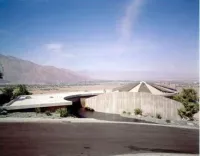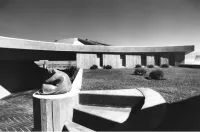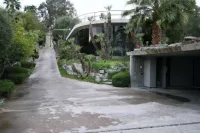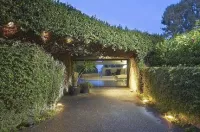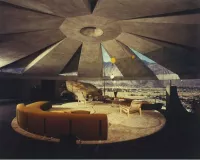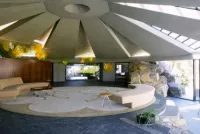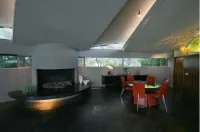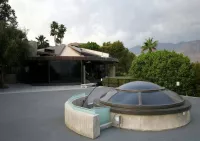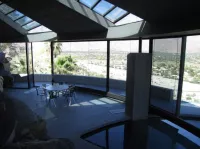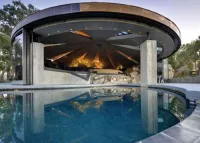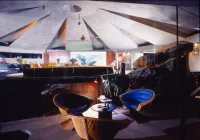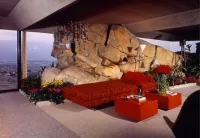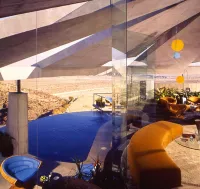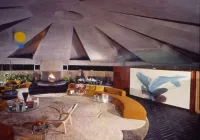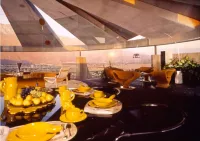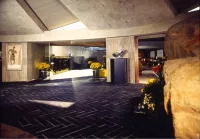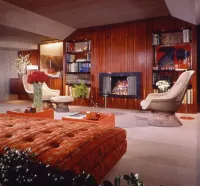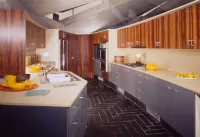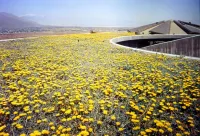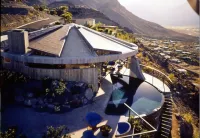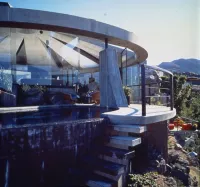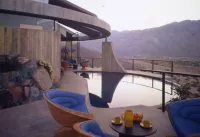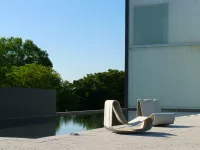Share what you know,
and discover more.
Share what you know,
and discover more.
Jan 23, 2019
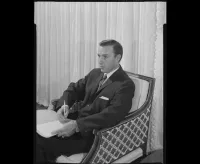
-

- Dave D
Arthur Elrod’s house is famous. Why isn’t he?
Arthur Elrod’s house is famous. Why isn’t he? by Fred Nicolaus Arthur Elrod designed homes for Walt Disney and Lucille Ball. Milo Baughman made his furniture. James Bond fought henchwomen in his living room. Yet the interior designer who defined Palm Springs modernism in the 1950s and ’60s has largely faded into obscurity. Now, journalist Adele Cygelman resurrects Elrod’s work in a compelling new book, Arthur Elrod: Desert Modern Design (Gibbs Smith). “People have been so interested in the architecture and furniture of the period for so long that it’s sucked up all the energy in the conversation,” Cygelman tells Business of Home. “I think people are starting to get tired of that, and more interested in the interior designers.” Cygelman’s book, as much a biography as a monograph, presents a thorough portrait of the decorator as a young man. Born in 1924 in South Carolina, Elrod was a farm boy, but he didn’t stay one for long. After attending Clemson, he made his way to the West Coast and never looked back. In Los Angeles, he studied interior design and took elocution lessons to lose his drawl. His early projects fit the prevailing Southern California style of the era: a moody version of Spanish colonial dominated by browns, beiges and heavy heirloom furniture. After moving to San Francisco in 1952, Elrod began to chart his own course. He was commissioned to create a museum installation for General Electric to celebrate the 75th anniversary of the light bulb, and the experience was a revelation. His “Celestial Room,” a mock “nighttime” penthouse, demonstrated advanced lighting equipment and ignited a lifelong fascination with new technology. From this experience, Elrod learned the importance of carefully controlling all aspects of a room, from the furniture to the lighting, for maximum effect. It was in Palm Springs, however, that Elrod found his muse. He opened up shop in the desert village in 1954, and his small firm was an immediate hit. Just as Elsie de Wolfe cleared out the cobwebs of Victorian style half a century earlier, Elrod began sweeping aside the trappings of Spanish colonial. The furniture got lighter and sleeker. The rooms got airier. And most importantly, Elrod brought a new palette—emerald greens, swimming pool blues, canary yellows—to the desert. “He had a saturated palette unmatched by anyone except maybe David Hicks,” says Cygelman. “Elrod was working like the color field painters of the era, but in 3-D.” The designer’s interest in new materials and technology placed him firmly in step with the Southern California architects of the 1950s and ’60s, who were pushing the envelope of modernism. Especially in the desert, spacious, open-plan ranch houses enclosed in glass were fast replacing adobe bungalows. Elrod enjoyed fruitful partnerships with the architects he worked with, and no matter the style, his homes tended to feature sophisticated stereos and lighting systems. Elrod was ahead of his time in another crucial respect: self-promotion and media savvy. In advance of his move to Palm Springs, he took out a series of illustrated ads in local papers that boasted the furniture brands he sold exclusively and established a charming aesthetic for the firm. More importantly, the ads led to editorial coverage in the papers, where Elrod remained a fixture for decades. And long before hordes of online influencers began pursuing strategic relationships and sponsored content, Elrod made the most of his handful of celebrity clients. A pair of homes he designed for Ball and Desi Arnaz led to extensive press coverage and a branded ad for Bigelow carpets that the meticulous Cygelman unearthed (“Only the best would do for Mr. and Mrs. Arnaz’s dream home”). Elrod went on to design homes for the likes of musician Hoagy Carmichael and Disney, but the designer’s most famous project was for himself. In 1968, he collaborated with architect John Lautner on an atomic-age fantasia in Palm Springs, now known as the Elrod House. The home—with its iconic circular glass-enclosed living room, concrete UFO roof and incorporated boulders—is a sleek modernist triumph, with a drop of camp. It endures to this day, partially due to a prominent scene in the James Bond film Diamonds Are Forever. The house was also notable for a less splashy reason: Elrod incorporated a pair of eventual continental classics—Pierre Paulin’s ribbon chair and Gaetano Pesce’s Up chair—into the design long before they became staples. Cygelman anecdotally credits him with bringing European furniture to the desert. At the tragically young age of 49, Elrod died in a car crash that also claimed the life of a design associate, William Raiser. His most iconic interiors were mostly removed in renovations throughout the following decades and his reputation began to fade away. Cygelman attributes his disappearance partially to the ephemeral nature of an interior designer’s work. However, she thinks Palm Springs might have had something to do with it: “He was out in the desert,” she says. “He was published, but people weren’t paying him the same attention they were to designers in New York and L.A.” Even in Palm Springs today, Elrod is mostly only remembered in connection to the iconic house that bears his name. His love of vibrant colors, however, has endured. “The design world can be so monochromatic and afraid of color,” says Cygelman. “But not in Palm Springs.”
Arthur Elrod’s house is famous. Why isn’t he?
Arthur Elrod’s house is famous. Why isn’t he? by Fred Nicolaus Arthur Elrod designed homes for Walt Disney and Lucille Ball. Milo Baughman made his furniture. James Bond fought henchwomen in his living room. Yet the interior designer who defined Palm Springs modernism in the 1950s and ’60s has largely faded into obscurity. Now, journalist Adele Cygelman resurrects Elrod’s work in a compelling new book, Arthur Elrod: Desert Modern Design (Gibbs Smith). “People have been so interested in the architecture and furniture of the period for so long that it’s sucked up all the energy in the conversation,” Cygelman tells Business of Home. “I think people are starting to get tired of that, and more interested in the interior designers.” Cygelman’s book, as much a biography as a monograph, presents a thorough portrait of the decorator as a young man. Born in 1924 in South Carolina, Elrod was a farm boy, but he didn’t stay one for long. After attending Clemson, he made his way to the West Coast and never looked back. In Los Angeles, he studied interior design and took elocution lessons to lose his drawl. His early projects fit the prevailing Southern California style of the era: a moody version of Spanish colonial dominated by browns, beiges and heavy heirloom furniture. After moving to San Francisco in 1952, Elrod began to chart his own course. He was commissioned to create a museum installation for General Electric to celebrate the 75th anniversary of the light bulb, and the experience was a revelation. His “Celestial Room,” a mock “nighttime” penthouse, demonstrated advanced lighting equipment and ignited a lifelong fascination with new technology. From this experience, Elrod learned the importance of carefully controlling all aspects of a room, from the furniture to the lighting, for maximum effect. It was in Palm Springs, however, that Elrod found his muse. He opened up shop in the desert village in 1954, and his small firm was an immediate hit. Just as Elsie de Wolfe cleared out the cobwebs of Victorian style half a century earlier, Elrod began sweeping aside the trappings of Spanish colonial. The furniture got lighter and sleeker. The rooms got airier. And most importantly, Elrod brought a new palette—emerald greens, swimming pool blues, canary yellows—to the desert. “He had a saturated palette unmatched by anyone except maybe David Hicks,” says Cygelman. “Elrod was working like the color field painters of the era, but in 3-D.” The designer’s interest in new materials and technology placed him firmly in step with the Southern California architects of the 1950s and ’60s, who were pushing the envelope of modernism. Especially in the desert, spacious, open-plan ranch houses enclosed in glass were fast replacing adobe bungalows. Elrod enjoyed fruitful partnerships with the architects he worked with, and no matter the style, his homes tended to feature sophisticated stereos and lighting systems. Elrod was ahead of his time in another crucial respect: self-promotion and media savvy. In advance of his move to Palm Springs, he took out a series of illustrated ads in local papers that boasted the furniture brands he sold exclusively and established a charming aesthetic for the firm. More importantly, the ads led to editorial coverage in the papers, where Elrod remained a fixture for decades. And long before hordes of online influencers began pursuing strategic relationships and sponsored content, Elrod made the most of his handful of celebrity clients. A pair of homes he designed for Ball and Desi Arnaz led to extensive press coverage and a branded ad for Bigelow carpets that the meticulous Cygelman unearthed (“Only the best would do for Mr. and Mrs. Arnaz’s dream home”). Elrod went on to design homes for the likes of musician Hoagy Carmichael and Disney, but the designer’s most famous project was for himself. In 1968, he collaborated with architect John Lautner on an atomic-age fantasia in Palm Springs, now known as the Elrod House. The home—with its iconic circular glass-enclosed living room, concrete UFO roof and incorporated boulders—is a sleek modernist triumph, with a drop of camp. It endures to this day, partially due to a prominent scene in the James Bond film Diamonds Are Forever. The house was also notable for a less splashy reason: Elrod incorporated a pair of eventual continental classics—Pierre Paulin’s ribbon chair and Gaetano Pesce’s Up chair—into the design long before they became staples. Cygelman anecdotally credits him with bringing European furniture to the desert. At the tragically young age of 49, Elrod died in a car crash that also claimed the life of a design associate, William Raiser. His most iconic interiors were mostly removed in renovations throughout the following decades and his reputation began to fade away. Cygelman attributes his disappearance partially to the ephemeral nature of an interior designer’s work. However, she thinks Palm Springs might have had something to do with it: “He was out in the desert,” she says. “He was published, but people weren’t paying him the same attention they were to designers in New York and L.A.” Even in Palm Springs today, Elrod is mostly only remembered in connection to the iconic house that bears his name. His love of vibrant colors, however, has endured. “The design world can be so monochromatic and afraid of color,” says Cygelman. “But not in Palm Springs.”
Jan 23, 2019
Arthur Elrod’s house is famous. Why isn’t he?
Arthur Elrod’s house is famous. Why isn’t he? by Fred NicolausArthur Elrod designed homes for Walt Disney and Lucille Ball. Milo Baughman made his furniture. James Bond fought henchwomen in his living room. Yet the interior designer who defined Palm Springs modernism in the 1950s and ’60s has largely faded into obscurity. Now, journalist Adele Cygelman resurrects Elrod’s work in a compelling new book, Arthur Elrod: Desert Modern Design (Gibbs Smith).
“People have been so interested in the architecture and furniture of the period for so long that it’s sucked up all the energy in the conversation,” Cygelman tells Business of Home. “I think people are starting to get tired of that, and more interested in the interior designers.”
Cygelman’s book, as much a biography as a monograph, presents a thorough portrait of the decorator as a young man. Born in 1924 in South Carolina, Elrod was a farm boy, but he didn’t stay one for long. After attending Clemson, he made his way to the West Coast and never looked back. In Los Angeles, he studied interior design and took elocution lessons to lose his drawl. His early projects fit the prevailing Southern California style of the era: a moody version of Spanish colonial dominated by browns, beiges and heavy heirloom furniture.
After moving to San Francisco in 1952, Elrod began to chart his own course. He was commissioned to create a museum installation for General Electric to celebrate the 75th anniversary of the light bulb, and the experience was a revelation. His “Celestial Room,” a mock “nighttime” penthouse, demonstrated advanced lighting equipment and ignited a lifelong fascination with new technology. From this experience, Elrod learned the importance of carefully controlling all aspects of a room, from the furniture to the lighting, for maximum effect.
It was in Palm Springs, however, that Elrod found his muse. He opened up shop in the desert village in 1954, and his small firm was an immediate hit. Just as Elsie de Wolfe cleared out the cobwebs of Victorian style half a century earlier, Elrod began sweeping aside the trappings of Spanish colonial. The furniture got lighter and sleeker. The rooms got airier. And most importantly, Elrod brought a new palette—emerald greens, swimming pool blues, canary yellows—to the desert. “He had a saturated palette unmatched by anyone except maybe David Hicks,” says Cygelman. “Elrod was working like the color field painters of the era, but in 3-D.”
The designer’s interest in new materials and technology placed him firmly in step with the Southern California architects of the 1950s and ’60s, who were pushing the envelope of modernism. Especially in the desert, spacious, open-plan ranch houses enclosed in glass were fast replacing adobe bungalows. Elrod enjoyed fruitful partnerships with the architects he worked with, and no matter the style, his homes tended to feature sophisticated stereos and lighting systems.
Elrod was ahead of his time in another crucial respect: self-promotion and media savvy. In advance of his move to Palm Springs, he took out a series of illustrated ads in local papers that boasted the furniture brands he sold exclusively and established a charming aesthetic for the firm. More importantly, the ads led to editorial coverage in the papers, where Elrod remained a fixture for decades.
And long before hordes of online influencers began pursuing strategic relationships and sponsored content, Elrod made the most of his handful of celebrity clients. A pair of homes he designed for Ball and Desi Arnaz led to extensive press coverage and a branded ad for Bigelow carpets that the meticulous Cygelman unearthed (“Only the best would do for Mr. and Mrs. Arnaz’s dream home”).
Elrod went on to design homes for the likes of musician Hoagy Carmichael and Disney, but the designer’s most famous project was for himself. In 1968, he collaborated with architect John Lautner on an atomic-age fantasia in Palm Springs, now known as the Elrod House. The home—with its iconic circular glass-enclosed living room, concrete UFO roof and incorporated boulders—is a sleek modernist triumph, with a drop of camp. It endures to this day, partially due to a prominent scene in the James Bond film Diamonds Are Forever.
The house was also notable for a less splashy reason: Elrod incorporated a pair of eventual continental classics—Pierre Paulin’s ribbon chair and Gaetano Pesce’s Up chair—into the design long before they became staples. Cygelman anecdotally credits him with bringing European furniture to the desert.
At the tragically young age of 49, Elrod died in a car crash that also claimed the life of a design associate, William Raiser. His most iconic interiors were mostly removed in renovations throughout the following decades and his reputation began to fade away. Cygelman attributes his disappearance partially to the ephemeral nature of an interior designer’s work. However, she thinks Palm Springs might have had something to do with it: “He was out in the desert,” she says. “He was published, but people weren’t paying him the same attention they were to designers in New York and L.A.”
Even in Palm Springs today, Elrod is mostly only remembered in connection to the iconic house that bears his name. His love of vibrant colors, however, has endured. “The design world can be so monochromatic and afraid of color,” says Cygelman. “But not in Palm Springs.”
Posted Date
Dec 20, 2021
Historical Record Date
Jan 23, 2019
Source Name
Business of Home
Delete Story
Are you sure you want to delete this story?
Apr 19, 2016
Apr 19, 2016
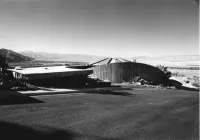
-

- Dave D
National Register of Historic Places - Summary
Summary The Arthur Elrod House was designed by John Lautner in the Mid-century Modern style with influences of Organic and Expressionist architecture. It is located on a prominent hillside site in Palm Springs, California. The Elrod House exhibits the horizontal emphasis, large expanses of glass, and open plan associated with Mid-century Modern architecture; while the dramatic domed concrete roof, circular living area, asymmetrical organization, and physical and visual connections to its hillside site reflect the influences of Organic and Expressionist design. Though alterations were made to the Elrod House over time, it retains significant character-defining features on the interior and exterior. It retains the integrity of location, design, setting, materials, workmanship, feeling, and association. Narrative Description The Arthur Elrod House is located on the west side of Southridge Drive in Palm Springs, California. The property is bounded on the south by adjacent residential development, on the west and north by the undeveloped hillside, and on the east by Southridge Drive. The property contains a split-level, single-family residence constructed in 1968 and modified by Lautner in 1971 and 1974. The house sits close to the street, at the upper portion of the downslope lot. It is designed in the Mid-century Modern style with pronounced Organic and Expressionist influences. It is constructed of reinforced concrete. The irregular plan is composed of a large circular volume housing the living area, guest room, and kitchen, with an angled wing to the south containing a master bedroom suite and carport. The living area has a shallow conical roof composed of a steel frame with alternating concrete and copper-clad triangular wedges. The copper-clad wedges are angled to create radial clerestory windows. The bedroom wing has a flat built-up roof with a wide fascia. The wing encloses a semicircular entrance court to the east, bisected by a concrete wall that curves in both plan and profile and divides the court into a driveway to the south and an entrance garden to the north, accessed by a copper-clad gate. The exterior walls are of exposed board-formed concrete and glass. The primary entrance is asymmetrically located in a wide recess on the south façade of the living wing and consists of a frameless glass door with fixed sidelights. The entrance is accessed by an exposed aggregate concrete walk. Fenestration consists of tall rectangular windows and high ribbon windows facing the entrance court and street, and walls of glass on the west façade. The entrance opens to the main living area, a 60-foot diameter, split-level open space surmounted by the shallow concrete dome. The dome is supported on a continuous concrete tension ring and concealed steel columns, giving the impression that it is suspended over the space. Large outcroppings of rock existing on the site were left in place and incorporated into the design. A broad staircase descends from the upper living area between two boulders to the lower pool terrace, which extends into the room. A sliding wall of glass opens the entire west side of the living area to the pool terrace and the vista beyond. The kitchen is concealed behind wood paneled partitions. Interior finishes include slate tile flooring, concrete walls and ceilings, and wood paneling. Alterations The living room’s original zigzagged frameless glass wall blew out in a windstorm in 1971 and was replaced with curved, retractable glass walls. After Elrod’s death in 1974, Lautner modified the house for subsequent owners. A lower-level guest wing was constructed north of the pool terrace, containing three additional bedrooms. Integrity Although there have been alterations to the property over time, the Elrod House retains all seven aspects of integrity. Location: The Elrod House remains on its original site. It retains the integrity of the location. Design: The Elrod House retains a majority of the significant character-defining features of its original Organic- and Expressionist-influenced Mid-century Modern design by John Lautner, including its concrete construction, irregular plan, entrance court, circular living area with a shallow domed roof, incorporation of existing boulders, interior organization and finishes, pool terrace, and integration with site and views. Later alterations, including the living area’s retractable glass walls and the addition of the guest wing, were designed by Lautner and so maintained the architect’s original design intent. It, therefore, retains the integrity of the design. Setting: The Elrod House remains on its sparsely-developed hillside setting and maintains its commanding views of Palm Springs and Mount San Jacinto. It retains integrity of setting. Materials: The Elrod House retains the majority of its historic materials, including its reinforced concrete structure, glass walls, stone outcroppings, slate flooring, and wood paneling. It retains the integrity of materials. Workmanship: The Elrod House retains the physical evidence of its mid-20th century construction techniques by master builder Wally Niewiadomski, including its reinforced concrete construction, frameless glass walls, and incorporation of existing boulders and outcroppings. It retains the integrity of workmanship. Feeling: The Elrod House retains the integrity of location, design, setting, materials, and workmanship, and continues to convey the aesthetic sense of its Organic- and Expressionist-influenced Mid-century Modern design. It, therefore, retains the integrity of feeling. Association: The property retains the integrity of location, design, setting, materials, workmanship, and feeling, which combine to convey its Organic- and Expressionistinfluenced Mid-century Modern design by master architect John Lautner. It, therefore, retains the integrity of the association.
National Register of Historic Places - Summary
Summary The Arthur Elrod House was designed by John Lautner in the Mid-century Modern style with influences of Organic and Expressionist architecture. It is located on a prominent hillside site in Palm Springs, California. The Elrod House exhibits the horizontal emphasis, large expanses of glass, and open plan associated with Mid-century Modern architecture; while the dramatic domed concrete roof, circular living area, asymmetrical organization, and physical and visual connections to its hillside site reflect the influences of Organic and Expressionist design. Though alterations were made to the Elrod House over time, it retains significant character-defining features on the interior and exterior. It retains the integrity of location, design, setting, materials, workmanship, feeling, and association. Narrative Description The Arthur Elrod House is located on the west side of Southridge Drive in Palm Springs, California. The property is bounded on the south by adjacent residential development, on the west and north by the undeveloped hillside, and on the east by Southridge Drive. The property contains a split-level, single-family residence constructed in 1968 and modified by Lautner in 1971 and 1974. The house sits close to the street, at the upper portion of the downslope lot. It is designed in the Mid-century Modern style with pronounced Organic and Expressionist influences. It is constructed of reinforced concrete. The irregular plan is composed of a large circular volume housing the living area, guest room, and kitchen, with an angled wing to the south containing a master bedroom suite and carport. The living area has a shallow conical roof composed of a steel frame with alternating concrete and copper-clad triangular wedges. The copper-clad wedges are angled to create radial clerestory windows. The bedroom wing has a flat built-up roof with a wide fascia. The wing encloses a semicircular entrance court to the east, bisected by a concrete wall that curves in both plan and profile and divides the court into a driveway to the south and an entrance garden to the north, accessed by a copper-clad gate. The exterior walls are of exposed board-formed concrete and glass. The primary entrance is asymmetrically located in a wide recess on the south façade of the living wing and consists of a frameless glass door with fixed sidelights. The entrance is accessed by an exposed aggregate concrete walk. Fenestration consists of tall rectangular windows and high ribbon windows facing the entrance court and street, and walls of glass on the west façade. The entrance opens to the main living area, a 60-foot diameter, split-level open space surmounted by the shallow concrete dome. The dome is supported on a continuous concrete tension ring and concealed steel columns, giving the impression that it is suspended over the space. Large outcroppings of rock existing on the site were left in place and incorporated into the design. A broad staircase descends from the upper living area between two boulders to the lower pool terrace, which extends into the room. A sliding wall of glass opens the entire west side of the living area to the pool terrace and the vista beyond. The kitchen is concealed behind wood paneled partitions. Interior finishes include slate tile flooring, concrete walls and ceilings, and wood paneling. Alterations The living room’s original zigzagged frameless glass wall blew out in a windstorm in 1971 and was replaced with curved, retractable glass walls. After Elrod’s death in 1974, Lautner modified the house for subsequent owners. A lower-level guest wing was constructed north of the pool terrace, containing three additional bedrooms. Integrity Although there have been alterations to the property over time, the Elrod House retains all seven aspects of integrity. Location: The Elrod House remains on its original site. It retains the integrity of the location. Design: The Elrod House retains a majority of the significant character-defining features of its original Organic- and Expressionist-influenced Mid-century Modern design by John Lautner, including its concrete construction, irregular plan, entrance court, circular living area with a shallow domed roof, incorporation of existing boulders, interior organization and finishes, pool terrace, and integration with site and views. Later alterations, including the living area’s retractable glass walls and the addition of the guest wing, were designed by Lautner and so maintained the architect’s original design intent. It, therefore, retains the integrity of the design. Setting: The Elrod House remains on its sparsely-developed hillside setting and maintains its commanding views of Palm Springs and Mount San Jacinto. It retains integrity of setting. Materials: The Elrod House retains the majority of its historic materials, including its reinforced concrete structure, glass walls, stone outcroppings, slate flooring, and wood paneling. It retains the integrity of materials. Workmanship: The Elrod House retains the physical evidence of its mid-20th century construction techniques by master builder Wally Niewiadomski, including its reinforced concrete construction, frameless glass walls, and incorporation of existing boulders and outcroppings. It retains the integrity of workmanship. Feeling: The Elrod House retains the integrity of location, design, setting, materials, and workmanship, and continues to convey the aesthetic sense of its Organic- and Expressionist-influenced Mid-century Modern design. It, therefore, retains the integrity of feeling. Association: The property retains the integrity of location, design, setting, materials, workmanship, and feeling, which combine to convey its Organic- and Expressionistinfluenced Mid-century Modern design by master architect John Lautner. It, therefore, retains the integrity of the association.
National Register of Historic Places - Summary
SummaryThe Arthur Elrod House was designed by John Lautner in the Mid-century Modern style with influences of Organic and Expressionist architecture. It is located on a prominent hillside site in Palm Springs, California. The Elrod House exhibits the horizontal emphasis, large expanses of glass, and open plan associated with Mid-century Modern architecture; while the dramatic domed concrete roof, circular living area, asymmetrical organization, and physical and visual connections to its hillside site reflect the influences of Organic and Expressionist design. Though alterations were made to the Elrod House over time, it retains significant character-defining features on the interior and exterior. It retains the integrity of location, design, setting, materials, workmanship, feeling, and association.
Narrative Description
The Arthur Elrod House is located on the west side of Southridge Drive in Palm Springs, California. The property is bounded on the south by adjacent residential development, on the west and north by the undeveloped hillside, and on the east by Southridge Drive. The property contains a split-level, single-family residence constructed in 1968 and modified by Lautner in 1971 and 1974. The house sits close to the street, at the upper portion of the downslope lot. It is designed in the Mid-century Modern style with pronounced Organic and Expressionist influences. It is constructed of reinforced concrete. The irregular plan is composed of a large circular volume housing the living area, guest room, and kitchen, with an angled wing to the south containing a master bedroom suite and carport. The living area has a shallow conical roof composed of a steel frame with alternating concrete and copper-clad triangular wedges. The copper-clad wedges are angled to create radial clerestory windows. The bedroom wing has a flat built-up roof with a wide fascia. The wing encloses a semicircular entrance court to the east, bisected by a concrete wall that curves in both plan and profile and divides the court into a driveway to the south and an entrance garden to the north, accessed by a copper-clad gate. The exterior walls are of exposed board-formed concrete and glass. The primary entrance is asymmetrically located in a wide recess on the south façade of the living wing and consists of a frameless glass door with fixed sidelights. The entrance is accessed by an exposed aggregate concrete walk. Fenestration consists of tall rectangular windows and high ribbon windows facing the entrance court and street, and walls of glass on the west façade.
The entrance opens to the main living area, a 60-foot diameter, split-level open space surmounted by the shallow concrete dome. The dome is supported on a continuous concrete tension ring and concealed steel columns, giving the impression that it is suspended over the space. Large outcroppings of rock existing on the site were left in place and incorporated into the design. A broad staircase descends from the upper living area between two boulders to the lower pool terrace, which extends into the room. A sliding wall of glass opens the entire west side of the living area to the pool terrace and the vista beyond. The kitchen is concealed behind wood paneled partitions. Interior finishes include slate tile flooring, concrete walls and ceilings, and wood paneling.
Alterations
The living room’s original zigzagged frameless glass wall blew out in a windstorm in 1971 and was replaced with curved, retractable glass walls. After Elrod’s death in 1974, Lautner modified the house for subsequent owners. A lower-level guest wing was constructed north of the pool terrace, containing three additional bedrooms.
Integrity
Although there have been alterations to the property over time, the Elrod House retains all seven aspects of integrity.
Location: The Elrod House remains on its original site. It retains the integrity of the location.
Design: The Elrod House retains a majority of the significant character-defining features of its original Organic- and Expressionist-influenced Mid-century Modern design by John Lautner, including its concrete construction, irregular plan, entrance court, circular living area with a shallow domed roof, incorporation of existing boulders, interior organization and finishes, pool terrace, and integration with site and views. Later alterations, including the living area’s retractable glass walls and the addition of the guest wing, were designed by Lautner and so maintained the architect’s original design intent. It, therefore, retains the integrity of the design.
Setting: The Elrod House remains on its sparsely-developed hillside setting and maintains its commanding views of Palm Springs and Mount San Jacinto. It retains integrity of setting.
Materials: The Elrod House retains the majority of its historic materials, including its reinforced concrete structure, glass walls, stone outcroppings, slate flooring, and wood paneling. It retains the integrity of materials.
Workmanship: The Elrod House retains the physical evidence of its mid-20th century construction techniques by master builder Wally Niewiadomski, including its reinforced concrete construction, frameless glass walls, and incorporation of existing boulders and outcroppings. It retains the integrity of workmanship.
Feeling: The Elrod House retains the integrity of location, design, setting, materials, and workmanship, and continues to convey the aesthetic sense of its Organic- and Expressionist-influenced Mid-century Modern design. It, therefore, retains the integrity of feeling.
Association: The property retains the integrity of location, design, setting, materials, workmanship, and feeling, which combine to convey its Organic- and Expressionistinfluenced Mid-century Modern design by master architect John Lautner. It, therefore, retains the integrity of the association.
Posted Date
Dec 20, 2021
Historical Record Date
Apr 19, 2016
Source Name
United States Department of the Interior - National Park Service
Delete Story
Are you sure you want to delete this story?
Jun 01, 2011
Jun 01, 2011
2175 Southridge Drive, Palm Springs, CA, USA
Posted Date
Dec 20, 2021
Historical Record Date
Jun 01, 2011
Source Name
Modern Design
Delete Story
Are you sure you want to delete this story?
May 01, 2011
May 01, 2011
John Lautner's Elrod House (Interior Photos)
John Lautner's Elrod House from Modern DesignPosted Date
Dec 20, 2021
Historical Record Date
May 01, 2011
Source Name
Modern Design
Delete Story
Are you sure you want to delete this story?
May 01, 2011
May 01, 2011
John Lautner's Elrod House (Exterior Photos)
John Lautner's Elrod HousePosted Date
Dec 20, 2021
Historical Record Date
May 01, 2011
Source Name
Modern Design
Delete Story
Are you sure you want to delete this story?


